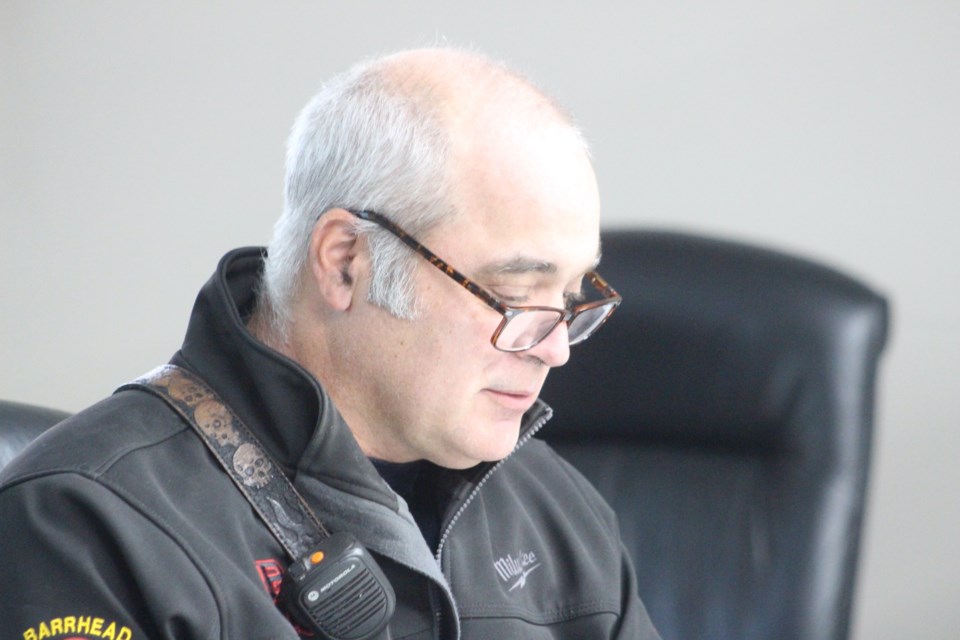BARRHEAD - Medical or ambulance assistance led the Barrhead Regional Fire Services (BRFS) responses list for the third quarter of 2023.
That is what BRFS chief Gary Hove told County of Barrhead councillors during their Dec. 5 meeting.
From July, August, and September firefighters' medical assistance calls accounted for roughly 48 per cent of the 120 BRFS responses for the quarter, accounting for over 105 hours of firefighter time.
Most responses were within the Town of Barrhead's borders at 41, while 16 were in the county. Combined, they accounted for over 41 hours of firefighter time.
Alarm investigations were the next highest category at 28, with the bulk, 18, occurring in the town while 10 were in the county, accounting for 12 hours of firefighter time.
"It is a nice change compared to the wildland fire calls," Hove said. "Which often account for most firefighter hours in the third quarter."
Rounding out the bottom of responses were 12 fire responses (structures and vehicle fires) at seven, with four being in the county and three in the town, 11 miscellaneous calls that do not fit into other categories, and four wildland fires.
Not included in the main statistics were eight motor vehicle accident calls on provincial highways and one mutual aid call. These categories are not included with the other categories as the calls are not charged to the Barrhead municipalities.
Deputy reeve Marvin Schatz asked if all the BRFS firefighters who volunteered as part of the province's larger wildland firefighting efforts had returned.
Hove said they had, adding the last group of firefighters deployed to High Level with Engine 5, returned in late September.
"They were there to put out ground fires, mostly along the highways," he said.
Reeve Doug Drozd interjected that he noticed that deputy chief Ted Amos was driving a new command vehicle. The county had loaned the department one of its older agricultural services pickups for several months after BRFS was forced to take Command 2 out of service after its engine imploded.
Hove noted that although the unit is incomplete, the emergency lighting and siren package are still on backorder; it is in service, including a second rapid attack wildland firefighting unit after a 200-water tank and pump were installed.
Coun. Walter Preugschas said he wanted to thank Hove and his firefighters for the effort in responding to his property. Late in the evening on Nov. 19, BFRS firefighters responded to a large grassfire that destroyed multiple unused outbuildings on Preugschas property.
The fire department responded with two fire engines, two water tenders and its wildland fire attack unit. In total, 17 firefighters helped extinguish the fire. The cause of the fire is unknown, but at the time, Hove speculated it could have come from an electrical spark from a nearby power pole that had been partially blown down by the windstorm that occurred that night.
"The process seemed to go well, and I appreciate everyone's efforts," he said.
Hove responded that the department appreciated Preugschas's efforts, saying he had mowed a path around the fire that helped contain it.
"Something like that can make a big difference," he said. "When farmers disc the outside edge of their fields, if it comes from outside or inside the field, it has a more difficult time getting out," he said. "It might not seem like much, but something as small as that can help control a fire."
Drozd interjected, saying if it had been a "normal November, even a skiff of snow would have stopped it in its tracks."
Hove agreed, saying they are getting more reports from concerned residents that permitted burns could "get out of hand" due to the dry conditions.
"It is a little bit drier, but the frost in the grass helps. It would be hard for a fire to spread today, but after a while of warm temperatures, we could start seeing grassfires again," he said.
Hove said he is keeping a close eye on the conditions, adding that, for now, the fire department is still issuing fire permits.
In the county's burning bylaw, after Dec. 15, Hove said they grant permits on a case-by-case basis.
"Then we start looking at how clean farmers' piles are. If it is a clean pile, with nothing but dry wood, it would burn hot and fast and be out," he said. "But not windrows or anything that will generate a lot of smoke."



